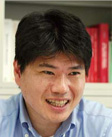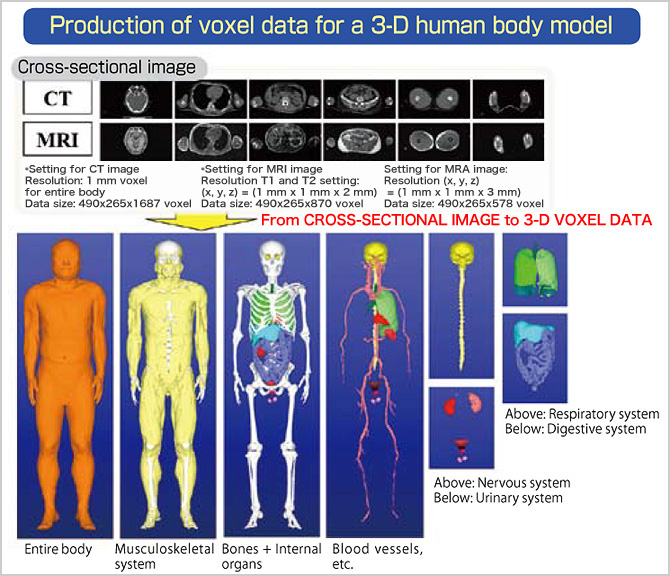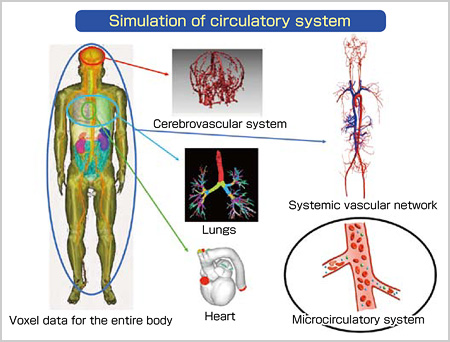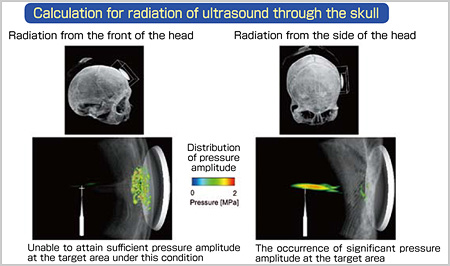
Organ and Body Scale Team
Develop a 3-D Model of the Entire Human
Body and Understand In Vivo Phenomena
to Utilize for Medical Purposes

Organ and Body Scale Team Team Leader
Shu TAKAGI
The general goals of our Organ and Body Scale Team are to develop a computer 3-D model of the entire human body with all its organs and systems, including the circulatory system, the respiratory system, the musculoskeletal system and the nervous system, based on image data obtained through MRI, CT and ultrasonography, etc. and to perform various simulations with this virtual human body for the purposes of acquiring a further understanding of biological phenomena, demonstrating the mechanisms of diseases, predicting pathological paths and ultimately making the simulations a useful tool for diagnosis and treatment in clinical practice. In other words, our goals are to bring the "static information" of medical image data to life and to revive it as dynamic information. Therefore, we think that it is a priority to develop and adapt new analytical methods such as the Eulerian fluid-structure coupling algorithm. The Lagrangian method is generally used in the analysis of solids and related equations are written based on the trajectory of a material point. This method requires the generation of a mesh in accordance with organ distortion and has the problem of poor affinity for voxel data of the entire body. On the other hand, the Eulerian method is commonly used in the analysis of fluids and related equations are written based on a fixed position in space through which a material moves. This method demands greater mathematical complexity, but becomes a very effective means of dealing with medical image data.

In our team, research is vigorously conducted by five sub-groups based on the target phenomena or study approaches. Specifically, these are " T h e s op his tic ation of voxel - dat a production for the entire body and the development of a model with respect to systemic dynamics among organs and their systems," "The development of a simulator for the in vivo propagation of ultrasound and heavy particle beams as a supportive tool for minimally invasive therapies," "The implementation of a heart simulator in next-generation supercomputers," "The development of avascularnetwork model and the integrated simulation of blood circulation " and" The integrated simulation of pulmonary respiration and pulmonary circulation." One of the ultimate goals of these projects is to find an answer to the question "What is life?" To us, the body is not simply represented by an assembly of separate organs. It functions as a whole as a result of organs that interact with each other. As such, an understanding of the entire body is our primary attitude towards our research. For example, vascular networks connect organs with each other and enable their different functions to work together organically as a whole. We therefore consider vascular networks to be very important and using voxel data of the entire body, we are currently aiming to develop an integrated multiscale circulatory-system simulator by establishing a dynamic model of blood circulation involving the heart, the arterial/venous vascular system and even the capillaries. Numerical analyses of the circulatory system are also performed in terms of dynamics in blood circulation, including the agglutination of platelets and red blood cells and adhesion to vessel walls in a condition of thrombosis or microcirculatory disturbances. In particular, studies on thrombosis are important because thrombosis, as a circulatory disorder, can cause serious harm to the body. When considering only blood vessels in the heart or brain being blocked with clots, we tend to take it as a local phenomenon, but blood clots can actually be formed as a result of the accumulation of the platelets activated in damaged vessels in any part of the body. Thrombosis, therefore, can affect every part of the circulatory system.

Blood plays an important role as a medium for transporting substances throughout the body. E x tremely impor tant, in par ticular, is the transportation of oxygen and carbon dioxide. In this sense, studies on the functions of the lungs become indispensable for research and we are working on the simulation of the process of gas exchange in the lungs. The heart, of course, is a crucial organ for life and a highly-advanced simulator for the heart, the multi-scale and multi-physics heart simulator, developed by the University of Tokyo, has been developed. If this simulator is implemented in next-generation supercomputers, it will even be possible to simulate everything from the movements of each cardiac muscle cell to the movements of the heart as a whole, thus making a major contribution toward advanced medical treatment for cardiac disease.

For medical applications, the research project we are committing to the most is the development of a simulator for less invasive radiation therapy using ultrasound or heavy particles. The cauterization of tumors found in prostate or breast cancer, with focused ultrasound, has been performed in actual clinical practice. Radiation can be very difficult, however, when the target organ is surrounded with bones or located deep inside the body, because the body consists of various parts that may have totally different acoustic wave propagation properties. Determining the intensity and focusing area for irradiation depending on the characteristics of individual bodies will become very useful in clinical practice. In the future, even the cauterization of brain tumors through the skull will become possible.
The key to simulating a living body, we believe, is a clear definition of where uncertainty is involved. For example, medical image data used to produce voxel data for the entire body itself has some degree of uncertainty, because it cannot illustrate the precise position of a surface. In my field of basic research on fluids, many researchers discuss how to reduce this uncertainty by a few percentage points, but in many cases, such strict accuracy is unnecessary in clinical practice. It is considered fundamental that "the human body is too complicated for the mechanisms of the body to be described simply and clearly." In the process of developing a model for something as complicated as the body, the occurrence of some uncertainty cannot be avoided. This does never mean, however, that uncertainty can be allowed in numerical calculation methods. Calculation methods have to be developed with mathematical consistency and with less uncertainty being involved. In each calculation method, it is essential to first have a clear understanding of where uncertainty is involved and where, consequently, accuracy is reduced and then to use the results of simulation with a living body model, which has some degree of uncertainty.
BioSupercomputing Newsletter Vol.1
- SPECIAL INTERVIEW
- Innovative Approach for Understanding Phenomena of Life Exploring New Possibilities with Bio-supercomputing
Computational Science Research Program Deputy Program Director Ryutaro HIMENO
- A Message from the Team Leader
- Simulations to Understand the Functions of the Biopolymers that Play Fundamental Roles in Life
Molecular Scale Team Team Leader Akinori KIDERA - Develop a 3-D Model of the Entire Human Body and Understand In Vivo Phenomena to Utilize for Medical Purposes
Organ and Body Scale Team Team Leader Shu TAKAGI - The Fourth Methodology (Data Analysis Fusion): Transforming Biology into a Predictable Science
Data Analysis Fusion Team Team Leader Satoru MIYANO
- Report on Research
- Prediction of Transmembrane Dimer Structure of Amyloid Precursor Protein using Replica-Exchange Molecular Dynamics Simulations
Molecular Scale Team Naoyuki MIYASHITA / RIKEN Advanced Science Institute (Molecular Scale WG) Yuji SUGITA - Simulation for Charged Particle Therapy
Organ and Body Scale Team Kenichi L. ISHIKAWA - Prospects of Prognostic Prediction Based on Genome-wide Association Study and Genetic/Non-genetic Factors
Riken Center for Genomic Medicine (Data Analysis Fusion WG) Naoyuki KAMATANI - Key Technology Supporting Petascale Computing
High-performance Computing Team Kenji ONO / Satoshi ITO / Daisuke WATANABE
